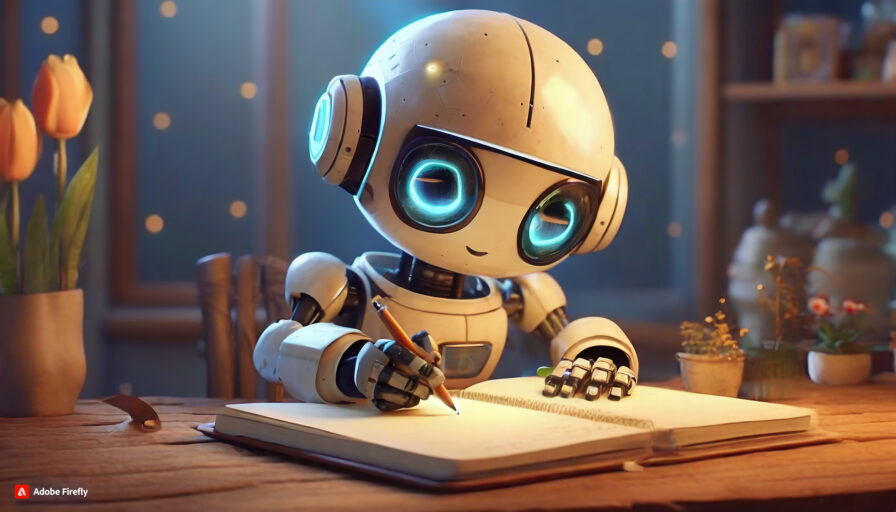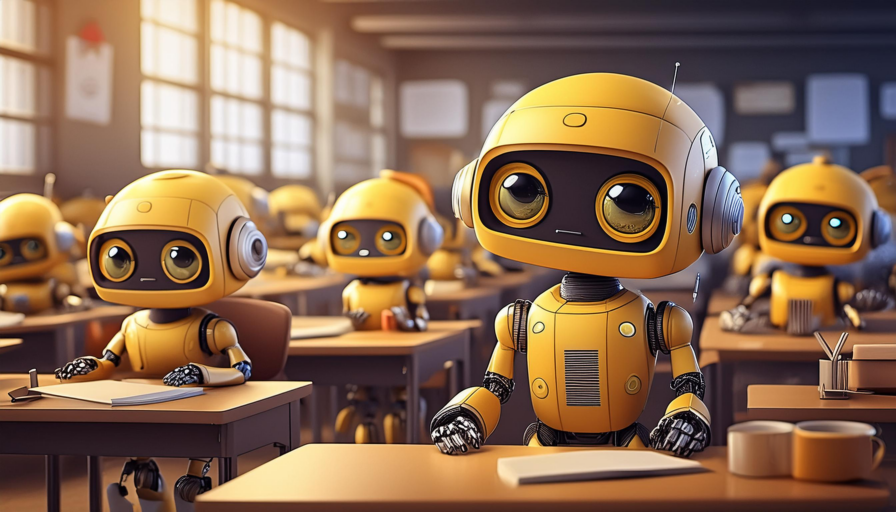There’s a $1 trillion industry that is about to be absolutely decimated by generative AI.
The companies in it are investing billions into figuring out how to survive. So far, they’ve come up with a three-point plan — and it’s a plan that can work for any creative professional, including artists, editors, and writers like me.
You see, I’m not only the editor here at MetaStellar, but I’m also a technology journalist. I’ve been covering enterprise technology for the past 20 years, and I spend all day every day talking to top business executives about how they’re using technology. Over the last couple of years, I’ve been talking to them about how they’re using generative AI.
I also talk to a lot of consultants. And the thing about the $1 trillion consulting industry is that it’s probably the one industry that’s most vulnerable to disruption due to generative AI.
So I’ve been asking them, “How’s this whole AI thing going for you? What are you guys planning to do about it?”
They are spending a lot of money trying to figure out what they’re going to do about it. PricewaterhouseCoopers is investing $1 billion. EY is investing $1.4 billion. Accenture is investing $3 billion.
Generative AI disrupts everything that involves expertise. If the value of your industry, your company, or your career is based on expertise, you are going to be disrupted. Lawyers, financial advisors, artists, writers, editors, consultants — they provide expertise. They give advice. They write computer code, they draw art, they take photographs, they write articles, they edit books, they give financial advice, legal advice. And whatever kind of expertise they’re using in their job, generative AI is coming for them.
If you’re one of those people whose career is built around their expertise — like I am — things are going to change, and things are gonna change very quickly. Generative AI is the fastest-changing technology I have ever seen — that anybody has ever seen. Companies are investing more money into this than I have ever seen invested.
This isn’t something you can sit out, you’re going to have to plan for it. But your plan does not mean that you have to become an AI expert. That’s one of the options, but there are alternatives.
And even if you don’t yourself plan to use AI, the publishing companies, the other creators, the other editors, the other artists — many of them are planning to use AI. So you need to know what they’re going to be doing so you can position yourself for survival.

Plan A: Go all-in on AI, bigly
Most of the money that consulting companies are investing in AI is going into Plan A — instead of being disrupted by AI, they’re going to be the ones doing disrupting by building their own AI systems.
They know full well that their corporate customers aren’t going to keep paying through the nose for consulting advice when they can get similar advice from ChatGPT for virtually nothing.
Now, ChatGPT does not currently have the ability to answer complicated business questions because it doesn’t have access to a company’s data, history, financial reports, marketing analysis, competitive analysis, and so on. Eventually, though, it will. Companies also want these AI systems to be safe, accurate, and completely secure. So consulting companies are in a race to build these business-safe systems before the AI companies do — and before their competitors do.
Now, how does that apply to writers, editors and artists? I mean, can you really build your own AI? Don’t these things cost like hundreds of millions of dollars?
They can, if you start from scratch. But if you start with a pre-trained model and just customize it, you can do it for a few bucks — or even completely for free. The tutorials for how to do this are all online. You don’t have to be an AI expert to do this. Regular artists and writers are building their own models right now. And publishing companies. Publishing companies are building their own models. And if you don’t know anything about generative AI and don’t know where to start — don’t worry. Nobody does. We’re all starting from scratch here.
They key is to use the AI you create to bring in new business. For example, if you’re an artist with a recognizable style, you can create your own AI that makes images in that style — or even complete book covers in that style — and instead of losing income to the generic AIs, you can make it into a profit center and a lead generator. Some customers will want to pay a little for an AI-generated work in your style, and others will want to pay more for a custom, human-made product. Either way, you keep the money. If you’re a writer, you can, say, create an AI that generates short stories set in your story universe in which the reader is the main character. If you’re an editor, you can create a custom GPT that analyses client work in a safe way, based on your unique approach to editing.
And these are just the low-hanging fruit of potential AI applications. Judging by the investment we’re seeing going into this space, and what’s already being released, we’re about to see an explosion of tools and apps like nothing we’ve ever seen before. You can be the next Uber. The next Angry Birds. The next Amazon, even. With generative AI, you don’t need technical skills to start — the AI can handle the technical side for you.
But aren’t all the AIs trained on stolen training data and are being sued by all the artists and writers? Some are. Others have been trained only on licensed data. The big one in this space is Adobe’s Firefly, but there are others, as well, such as the KL3M large language model released in February, and more. So no, you don’t have to steal someone’s work in order to build an AI.
And yes, all the images used to illustrate this article were generated using Adobe Firefly, so that artists were treated fairly.
Should you build your own AI model? You can, and you can be very successful at it, especially if you’re the first, or the best, or have a particular unique angle. But if you’re not going to be the first, or the best, or different in some special way, you can probably skip this option. Trying to build your own AI will use up a lot of resources that might be better put towards Plan B and Plan C, which I’m going to cover in a minute.
But you should still be aware that Plan A exists, and that some of your competitors will be all over it. Don’t be surprised, don’t waste too much time complaining about it — just be prepared and have a plan of your own for how to deal with it. I’ll give you some ideas for how in the last part of this article.

Plan B: Use the AI
Whether or not they admit it, most people are already using generative AI. You might not even know that you’re doing it. Search engines? They’re adding generative AI. Your phone’s voice assistant? AI is already here, or on its way. Grammar checkers? All over it. All those photo filters used to touch-up photographs? They’re getting a lot better, quickly, due to the new AIs.
Every software vendor that I’m talking to is adding generative AI to improve functionality, to improve user interfaces, or to add new features that just weren’t possible before.
Microsoft Word is adding AI to help you write better. Your blogging platform is adding AI to help you generate better post titles and promote your work. Canva has added AI. Everything has AI.
But that’s not what the consulting firms are thinking about when they talk about using AI to dramatically improve productivity. After all, if the AI is included in a tool that everybody uses, then the AI is no longer a competitive advantage — it’s something that everybody has. Instead, they’re getting out in front of everyone else, by finding new ways to use AI to become even more productive.
Think about how when photography was first invented, portrait painters were losing it over what was going to happen to them. Some leaned into the new tech and took their skills at composition, lighting, and getting people to pose, and became portrait photographers — while others continued to paint by hand, but used photography to become more productive such as, for example, working from photographs instead of making their subjects sit still for hours.
Today, an artist can, say, quickly generate inspiration images in their own style for a client to choose from, then paint the final painting by hand. Or have the AI create the first draft of the product, then add finishing touches to it manually. Or create the first draft manually, then use AI to refine the final work.
Editors can use AI to do the first-pass on a piece of text, then add their own analysis on top of that. Or start out with a manual evaluation, and use the AI to check for anything they might have missed. Either way, an editor using AI is going to be more productive than an editor who doesn’t. And I’m not talking about using the built-in AI editing tools that everyone has. I’m talking about being out on the cutting-edge. For example, today, the smartest AI is Anthropic’s Claude AI. It has a context window of 150,000 words — this means that you can upload an entire novel and ask it to find plot holes. And it will — even if nobody on the Internet has seen this novel before, and nobody has analyzed it. It’s not just giving a summary of what other people thought about it — it’s doing its own original analysis. Yup, it’s that good. Go try it out — the basic plan is free, and it doesn’t train on your data.
And, of course, writers can also use generative AI to find plot holes and story problems so that they can fix them before their send the book off to a human editor, so that the editor can work on more advanced problems. Writers can also use AI to brainstorm ideas, to generate outlines, to write rough drafts, to polish final manuscripts, to create series bibles. You can even use AI to invent a whole new language to your specifications — then translate text into and out of that language.
Many writers are already doing this. A Japanese writer just used AI to help write a sci-fi novel that won Japan’s most prestigious literary award.
If you want to learn more about how to use AI to improve your writing, check out The Creative Penn, The Nerdy Novelist, and Future Fiction Academy for tons of free content, author interviews, tutorials, and more.

Plan C: Be human
Whether or not you plan to use AI to find new revenue streams or improve your productivity, you should definitely take inspiration from the “being human” plan that consulting companies are working on.
You can be human without doing AI, or, as the consulting firms are doing, in conjunction with AI-based strategies. It involves leaning into the particularly human aspects of your profession and marketing them heavily.
After all, nobody is going to buy an sweater with uneven knitting, ragged threads, ugly colors, and a cost ten times higher than other sweaters — until they learn that it’s hand-made, by a local craftsperson, and Taylor Swift has one just like it.
So you don’t have to use the latest technologies and become ten times more productive than you were before to survive in the age of AI. You can survive by leaning into your human side.
For consultants, that means providing compassion, motivation, human empathy and understanding, helping clients overcome resistance to change, cheerleading, and hand-holding.
AIs can’t do that because they’re not real. Not yet, anyway. We know that the Duolingo owl doesn’t really care if we study Spanish or not and we will readily swipe to make it go away. We wouldn’t do that to a message from our best friend.
Editors can lean into being human by offering emotional support, guidance and cheerleading to their clients. Artists can capitalize on the fact that the hand-made art is available in very limited quantities and not everyone can get it — or afford it. Writers can turn their slow, painstaking writing into a compelling marketing advantage.
So how do you do this?
First, look for opportunities to meet with your public face-to-face. Read your books at local libraries and bookstores, go to conventions, attend other literary events, accept invitations from small book clubs. And forge personal connections using other channels as well like personal emails or newsletters, podcasts and YouTube videos, Zoom events, and, of course, social media. And if you do use digital channels, be very deliberately human. Don’t over-produce your videos. Instead of using AI or other automation tools to do your social media and spam your followers with generic content, be unique, different, authentic, quirky, and flawed.
What do you think? What’s your plan for AI? Are you excited about the potential opportunities? Are you going to lean into being human? Or are you looking forward to early retirement? Let me know in the comments — or watch me talk about all this stuff in the video below:

MetaStellar editor and publisher Maria Korolov is a science fiction novelist, writing stories set in a future virtual world. And, during the day, she is an award-winning freelance technology journalist who covers artificial intelligence, cybersecurity and enterprise virtual reality. See her Amazon author page here and follow her on Twitter, Facebook, or LinkedIn, and check out her latest videos on the Maria Korolov YouTube channel. Email her at maria@metastellar.com. She is also the editor and publisher of Hypergrid Business, one of the top global sites covering virtual reality.

